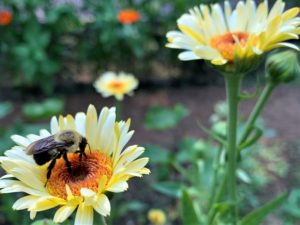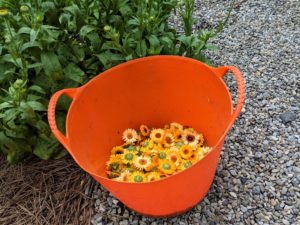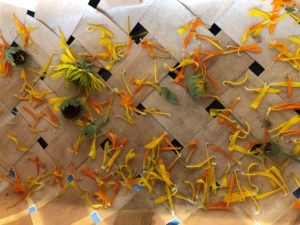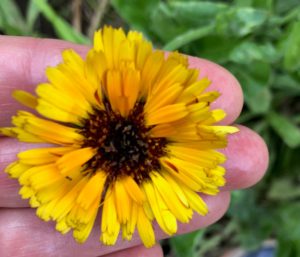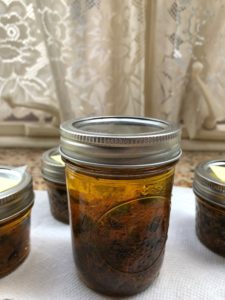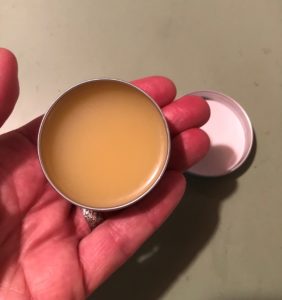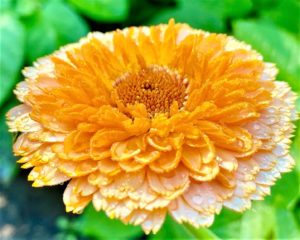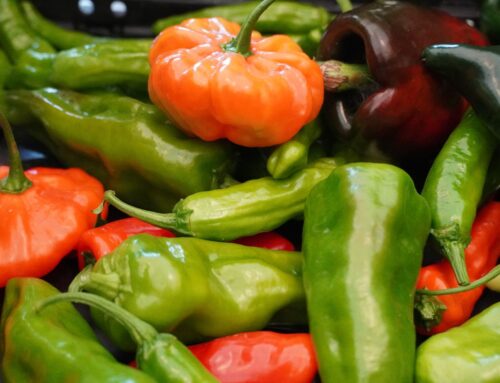The following represents an exploration of historic and modern uses of herbal plants for health and wellness. We recommend that everyone consult with their doctor before using herbal remedies. Calendula has not been approved for medicinal use by the FDA.
This year, during the height of the COVID pandemic, I decided to not only grow more of my own food, but also to see what in my garden could be used for healing. Though not an herbalist by trade, I am a home gardener who has found that the benefits of my homemade infused oils and salves of calendula, lavender, rosemary, and St. John’s wort have aided my health with their antibacterial, antifungal, antiseptic, and anti-inflammatory properties.
Calendula (Calendula officinalis) is quite an impactful herb, given it can be used as an effective medicinal, a colorful addition to culinary dishes, and a beloved nectar for butterflies and native bees. It is also a plant with a long and storied folk history.
Calendula’s name derives from the Latin calendae, referring to its long blooming season, which holds true in our area as it can be harvested in spring, summer, and fall. The species name is officinalis, which refers to its use in apothecaries and pharmacopoeias as the official medicinal species of its genus. With a harvest of three seasons and a usage that could help you feel better, I hope you are convinced to buy calendula seeds this winter and give them a place in your garden in the spring.
Calendula may be new to some of us, but the truth is, it has been around for a long time. The plant was first described in the 3rd century BCE and was an important character of the garden of 5th century France. Calendula has been planted in England since the 1200s, and it came to the New World with the first European settlers for use as a coloring agent in foods. By the 1880s, doctors had realized that the plant, used as a poultice, could stop bleeding. By the time of the Civil War, most doctors in the United States carried dried calendula flower heads in their medical bags to stop bleeding and to promote the healing of wounds.
My goal in this writing is to provide you with the information you need to grow, gather, and prepare calendula. This is not intended as medical advice (please consult your doctor before beginning any herbal treatment), but there is much to learn from the historic uses of these common garden plants, and much that is worth carrying into the future. For an in-depth review of some of the studies that have been done on the medicinal properties of species in the Calendula genius, check out this article “A Review of the Phytochemistry and Ethnopharmacology Aspects of Genus Calendula” by Disha Arora et al.
Planting Instructions
Mark a row, and drop seeds every six inches, cover with ¼” to ½” soil, pat gently, and water. Planting seeds should occur about two weeks before your last frost date (anywhere from mid-April to mid-May). Rows should be 18 inches apart. When plants are two to three inches high, thin to one foot apart. They will begin to bloom in eight weeks and will continue to give you flowers to harvest until the first hard frost. Calendula can be grown in containers or beds in full sun (six or more hours of sun) to part shade (three to six hours of sun). Flowers last longer in filtered sun or shady areas. Plant height will be 18 to 24 inches. If you notice aphids, spray them with water.
Preserving and Using Calendula Flowers
Pick flowers early in the morning, as soon as the dew has dried from the petals. You may want to pick the blooms two to three times a week once the flowers open, but you can harvest anytime during flowering. Don’t leave too many blossoms to set seed, or the plant will stop producing new flowers. Save some flowers for next year’s seeds.
When harvesting calendula for medicinal uses, it is important to dry the entire flowerhead including the green base, which holds the majority of the medicinal properties. After harvesting, your fingers will likely be sticky from resinous bracts, which form the green base of the flower head. Calendula leaves do not have a medicinal purpose and thus should not be harvested. Make sure the flower head is bright yellow or orange, as this is a sign of quality and freshness.
Dry flower heads on a screen or in an airy basket in a well-ventilated, warm area (I use my screened porch). I separate the petals from the green base to aid in faster dehydration time. Gently shake the drying calendula every day, so all parts of the flower head will dry, which should take two to three days. Ensure the entire flowerhead is dry to prevent an oil infusion from developing mold.
Store the flowers in glass jars with a tight lid or in paper bags. Keep them out of direct sunlight.
Culinary and Medicinal Uses
Eating the Petals:
Calendula flower petals (don’t use the green base of the flower) are a fun addition to rice dishes (adds yellow color, hence one of the common names – poor man’s saffron!) Fresh or dried flowers can be added to tossed salads, stews, soups or a few petals can be added to a jar of fermented lemons or other citrus fruits.
Oil Infusion:
Calendula-infused oil has been used as a massage oil to encourage lymphatic drainage, to reduce swelling, pain, and inflammation, and to promote the healing of tissue, cuts, and wounds. It is a wonderful wintertime skin boost to soothe and heal dry, cracked skin. Shelf life is one year if protected from light, heat, and moisture.
- Fill a clear glass jar with dried calendula flowers.
- Add enough olive oil or sweet almond oil to completely cover the calendula flowers.
- Let sit in a sunny window for four to six weeks.
- Strain out the flowers using cheesecloth. Be sure to wring out the cheesecloth to get all the resin/oil from the flowers.
- Discard the flowers and reserve the oil.
- Store the oil in a colored (amber or blue) glass bottle or metal tin. Label the jar or tin with its name and uses, and write an expiration date one year from the date you completed the oil infusion.
Salve:
Calendula salves have been used for wounds, burns, bruises, scars, blisters, diaper rash, eczema, and dry skin.
- Heat the calendula-infused oil in a double boiler, or improvise using a can in heated water.
- Add three to four teaspoons of melted beeswax per half cup of warmed oil. Stir until the wax is completely melted.
- Pour into a suitable glass or metal container.
- Seal with a lid once the mixture has hardened.
Tea:
You can drink the tea, use it as a soothing mouthwash, or as a wash for sunburns.
- Add one tablespoon of fresh, or two teaspoons of dried flowers to a cup of water.
- Bring to a boil and simmer with the lid on for ten minutes.
- To drink the tea, I would suggest that you add some honey or maple syrup to tone down its bitter taste.
- Refrigerate for up to one week any tea you don’t use right away.
Tincture:
Calendula tinctures have been used to help with menstrual cramps, ulcers, stomach upset, GERD, fever, and act as a support to the liver. Calendula tincture can be used as a wound wash or taken internally (one teaspoon three times a day).
Tinctures are made by pouring alcohol over dried blossoms and allowing the mixture to sit for six to eight weeks. Tinctures made with alcohol have a shelf life of 4 to 6 years and a shelf life of 14 to 24 months if made with glycerite, when stored in an amber or blue jar with a screw lid in a dark place.
- Add ½ cup of dried and finely chopped blossoms to a glass jar.
- Cover the flowers with 1 cup of 40%-50% alcohol/80 proof-100 proof (vodka is neutral tasting and generally inexpensive, or you may prefer the tastes of gin, rum or whiskey. Do not use ethanol alcohol). If you desire an alcohol-free tincture, make glycerite. To do so, mix 3 parts organic vegetable glycerine and 1 part distilled water, in place of the alcohol. Shake to combine. Pour liquid in a jar to cover herbs completely.
- Cap tightly and shake the jar several times a week.
- Allow the mixture to infuse for 6-8 weeks in a cool, dark cupboard.
- Strain out the flowers using a cheesecloth and compost them.
- Transfer the tincture to a clean, glass container, label it with the name and date, and completely cover to fill the jar.
Caution: Calendula should not be used during pregnancy. Those with a ragweed allergy should test a small amount of the infused oil and salve to make sure there is not a negative skin reaction, such as a rash. Consult your doctor before beginning herbal treatment.
As the fall season comes to a close, I hope you will consider calendula as you go through your seed catalogs and plan out your garden this winter. If you happen to see me at Tyler, feel free to ask me for a sample of lavender or calendula salve; I always have a bit in my purse or pocket because you never know when you or someone else will need it!


